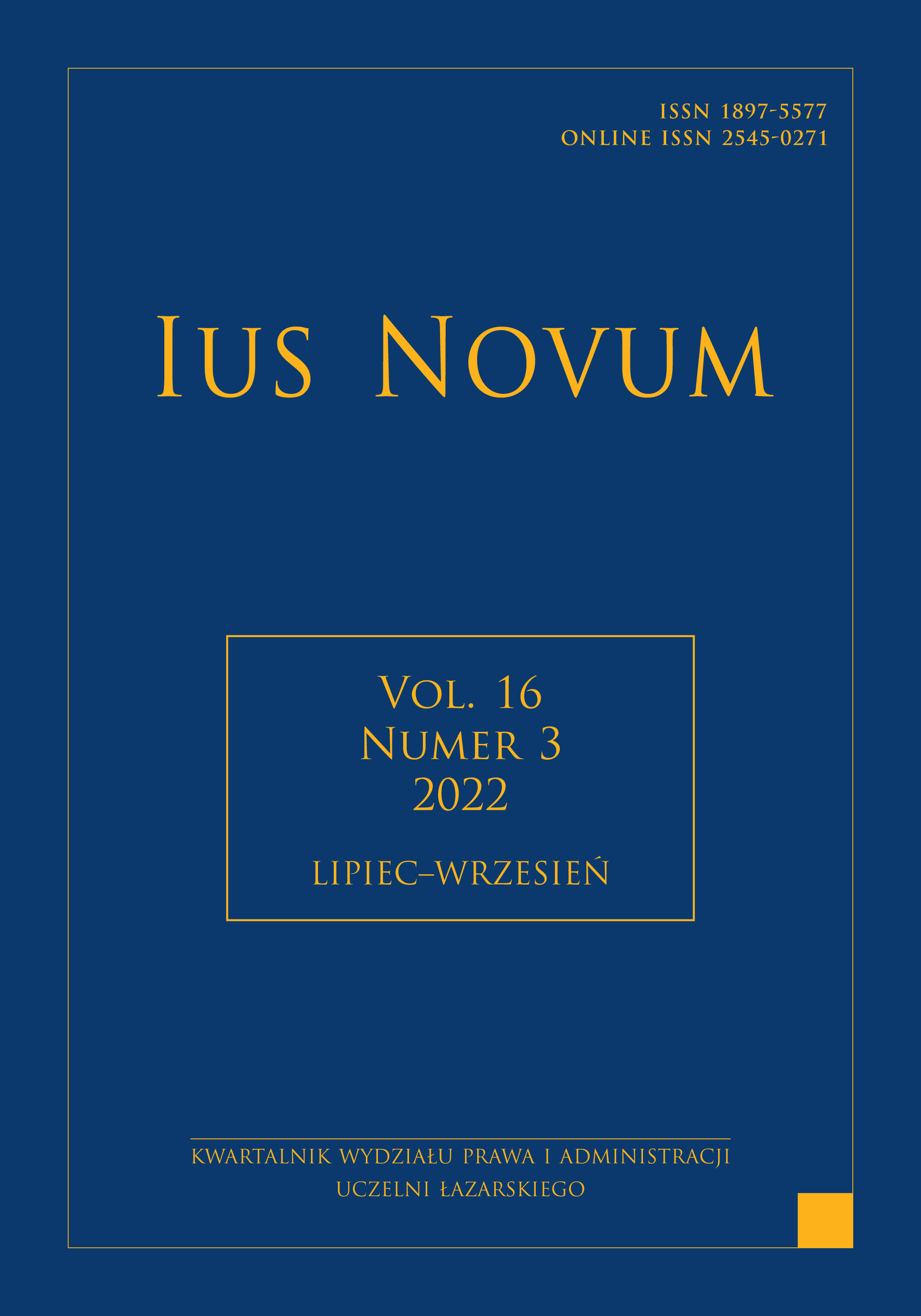Abstract
The article discusses the issues concerning the influence of the Polish legislative power
on the functioning of the Constitutional Tribunal that started in the autumn of 2015. The
analysis covers all legal acts passed between 2015 and 2017 that introduced changes in the
structure and functioning of the Constitutional Tribunal and modified the status of its judges.
The research made use of the innovative method devised by Professor Paweł Chmielnicki,
which consists in the examination of substantial sources of law, i.e. real reasons for passing
a given statute. The analysis covers, inter alia, materials developed by a group of specialists,
including the author, employed by the Centre for Legislative Process Research at Lazarski
University. The article shows that the changes in the Constitutional Tribunal do not serve
to exercise citizens’ rights. They aim to strengthen the political authorities (the Parliament
and its emanation, the Government) at the judicial power expense. It matches the general
tendency visible after the 2015 parliamentary election targeted at weakening the position of the judiciary and personal influence of the legislative on this power. The activities do not follow the constitutional rule of separation of powers and are in conflict with the principle of
separation and independence of courts and tribunals guaranteed by the Constitution. Taking
into account the fact that authorities change in the conditions of a democratic system, the
only panacea for the restoration of the shape and prestige of the Constitutional Tribunal is
the change of the authorities. There will be an opportunity for that in the autumn of 2023.
References
Literatura
Antoszewski A., Metodologiczne aspekty badań nad współczesnymi systemami politycznymi, „Studia
Nauk Politycznych” 2004, nr 1.
Balicki R., Władza sądownicza w Polsce – model konstytucyjny i rzeczywistość polityczna po wyborach
w 2015 roku, w: T. Słomka (red.), Demokracja konstytucyjna w Polsce, Warszawa 2019.
Banaszak B., Hasło „system rządów”, w: U. Kalina-Prasznic (red.), Encyklopedia prawa, Warszawa
Barendt E., Separation of Powers and Constitutional Government, „Public Law” (1995), nr 5.
Bonelli M., Claes M., Judical Serendipity: How Portuguese Judges Came to the Rescue of the Polish
Judiciary, Cambridge 2018.
Booth J.F., Freyens B.P., A Study of Political Activism in Labour Courts, „Ecocomics Letters”
, vol. 123.
Chmielnicki P., w: P. Chmielnicki (red.), A. Dybała, M. Stachura, Activity Rules of Economic Man
in Society as the Source of Legal Norms, Warsaw 2010.
Eisenmann Ch., La centralization et la decentralization: Principes d’une théorie judridique, „Revue
du droit public et de science politique en France et à l`étranger” 1947, t. LXIII, nr 3.
Górecki D., Pozycja ustrojowo-prawna Prezydenta Rzeczypospolitej Polskiej i rządu w ustawie konstytucyjnej
z 23 kwietnia 1935 roku, Łódź 1992.
Jemielniak J., Nielsenm L., Olsen H., Establishing Judicial Authority in International Economic Law,
„Cambridge International Trade and Economic Law” 2016.
Koopmans T., Subsidiarity, Politics and the Judiciary: Articles EC 5, Draft Convention I-9; Protocol
on the application of the principles of subsidiarity and proportionality, „European Constitutional
Law Review” 2004, vol. 1.
Kosař D., Baroš J., Dufek P., The Twin Challenges to Separation of Powers in Central Europe: Technocratic
Governance and Populism, „European Constitutional Law Review” 2019, vol. 15, iss. 3.
Kowalski J., Lamentowicz W., Winczorek P., Teoria państwa i prawa, Warszawa 1986.
Likert R., A Technique for the Measurement of Attitudes, „Archives of Psychology” 1932, nr 140
Malta P., Essai sur la notion de pouvoir hiérarchique, Paris 1961.
Oniszczuk J., Konstytucja RP w orzecznictwie Trybunału Konstytucyjnego, Warszawa 2000.
Państwo w czasach zmiany, M. Pietraś, I. Hofman, S. Michałowski (red.), Lublin 2018.
Pietrzak M., Rządy parlamentarne w Polsce w latach 1919–1926, Warszawa 1969.
Pułło A., Podział władzy. Aktualne problemy w doktrynie, prawie i współczesnej dyskusji konstytucyjnej
w Polsce, „Przegląd Sejmowy” 1993, nr 3.
Rakowska-Trela A., Sądy i sędziowie wobec niedemokratycznych przemian, „Studia Politologiczne”
, nr 47.
Sarnecki P., Uwagi do art. 10 Konstytucji, w: L. Garlicki (red.), Konstytucja Rzeczypospolitej Polskiej.
Komentarz, t. V, Warszawa 2007.
Słomka T., Stan demokracji konstytucyjnej w Polsce na tle modelu transformacji systemowej,
w: T. Słomka (red.), Demokracja konstytucyjna w Polsce, Warszawa 2019.
Słomka T., Władza sądownicza w warunkach kryzysu demokracji konstytucyjnej, „Przegląd Prawa
Konstytucyjnego” 2020, nr 4.
Sylwestrzak A., Władza trzecia „neutralna”, „Zeszyty Prawnicze” 2011, nr 4.
Trzciński J., Uwagi do art. 173 Konstytucji, w: Konstytucja Rzeczypospolitej Polskiej. Komentarz,
t. I, Warszawa 1999.
Winczorek P., Komentarz do Konstytucji Rzeczypospolitej Polskiej z dnia 2 kwietnia 1997 r., Warszawa
Dokumenty legislacyjne
Druk nr 963 z dnia 26 października 2016 r. – Uzasadnienie, s. 33–34,
http://orka.sejm.gov.pl/Druki8ka.nsf/0/8554E3131D10A999C12580590047A67F/%24File/963.pdf.
Opinia Sądu Najwyższego do projektu ustawy, s. 8, http://orka.sejm.gov.pl/Druki8ka.nsf/0/
B13459CB92DC1A84C125807C00492025/%24File/963-004.pdf.
Pełny zapis przebiegu posiedzenia Komisji Sprawiedliwości i Praw Człowieka (nr 53) z dnia
listopada 2016 r., s. 40, http://orka.sejm.gov.pl/Zapisy8.nsf/0/56EE7FC37C407939C-
B58A9/$file/0128708.pdf.
Pełny zapis przebiegu posiedzenia Komisji Sprawiedliwości i Praw Człowieka (nr 44)
z dnia 17 października 2016 r., s. 128, http://orka.sejm.gov.pl/Zapisy8.nsf/0/AC2ECA007951910FC1258065004CE1F6/$
file/0111308.pdf.
Uzasadnienie do projektu ustawy z dnia 30 listopada 2016 r. o organizacji i trybie postępowania
przed Trybunałem Konstytucyjnym (Dz.U. z 2016 r., poz. 2072), http://orka.sejm.gov.
pl/Druki8ka.nsf/0/8554E3131D10A999C12580590047A67F/%24File/963.pdf.
Uzasadnienie projektu ustawy z dnia 22 lipca 2016 r. o Trybunale Konstytucyjnym (Dz.U.
z 2016 r., poz. 1157), http://orka.sejm.gov.pl/Druki7ka.nsf/0/699F4137C13BF1E7C1257BB-
B2874/%24File/1590.pdf. Por. Wniosek Rzecznika Praw Obywatelskich z dnia
sierpnia 2016 r., s. 4, https://www.rpo.gov.pl/sites/default/files/Wniosek%20do%20
TK%20ws.%20ustawy%20o%20Trybunale%20Konstytucyjnym%20z%2022%20lipca%20
%2C%2002.08.2016.pdf.
Pozostałe źródła
Raport: Pracuje tak jak powinien?, https://www.hfhr.pl/wp-content/uploads/2018/03/
HFPC-Pracuje-tak-jak-powinien-raport-TK-2017.pdf#xd_co_f=YTIwMWQ3NDAtNGRh-
Ny00NzIzLWE0YmEtY2UzYWUwNTJiNWRm~.
Raport: Oceny oddziaływania instytucji publicznych, https://www.cbos.pl/SPISKOM.
POL/2021/K_038_21.PDF.
Wniosek Rzecznika Praw Obywatelskich z dnia 2 sierpnia 2016 r., s. 4, https://www.rpo.gov.
pl/sites/default/files/Wniosek%20do%20TK%20ws.%20ustawy%20o%20Trybunale%20
Konstytucyjnym%20z%2022%20lipca%202016%2C%2002.08.2016.pdf.

